The Old Quarter’s unique layout stems from its historical organization around 36 streets, each traditionally specializing in a specific craft or trade, creating a distinctive grid of commerce and culture that attracts millions of visitors annually. SIXT.VN offers tailored travel solutions to explore this vibrant district, ensuring an immersive experience into Hanoi’s heritage and bustling streets. Discover the cultural heart of Vietnam with ease, exploring ancient architectures and local cuisine with SIXT.VN’s expertly curated tours.
1. What Makes Hanoi’s Old Quarter So Special?
Hanoi’s Old Quarter is special because of its well-preserved historical architecture, vibrant street life, and unique commercial layout, where each street was traditionally dedicated to a specific trade. This combination of factors creates a captivating atmosphere that blends the past and present, making it a must-visit destination.
1.1 A Living Museum of Vietnamese History
The Old Quarter is essentially a living museum. The architecture, street names, and bustling atmosphere reflect centuries of history and culture. Exploring the area is like stepping back in time, providing a tangible connection to Hanoi’s past. The Old Quarter’s resilience is truly remarkable, surviving countless wars and occupations while retaining its character and charm. Preserving such history gives you an authentic look into Vietnam’s heritage.
1.2 The 36 Streets: A Testament to Traditional Craftsmanship
The heart of the Old Quarter lies in its 36 streets, each traditionally dedicated to a specific craft or trade. This unique layout is not just a historical relic but a living testament to the craftsmanship and entrepreneurial spirit of Hanoians. From silk to silver, each street offers a glimpse into the skills and traditions passed down through generations.
1.3 Vibrant Street Life: A Sensory Overload
The Old Quarter is a sensory experience like no other. The streets are alive with the sounds of vendors hawking their wares, motorbikes weaving through crowds, and the aromas of delicious street food wafting through the air. This constant activity is part of the Old Quarter’s charm, creating a vibrant and energetic atmosphere.
1.4 Cultural Fusion: A Blend of Influences
Over the centuries, Hanoi has been influenced by various cultures, including Chinese and French. The Old Quarter reflects this fusion of influences in its architecture, cuisine, and customs. This blend of cultures creates a unique identity that sets Hanoi apart from other cities in Southeast Asia.
1.5 A Hub for Authentic Vietnamese Cuisine
Food lovers will find themselves in heaven in the Old Quarter. The area is renowned for its authentic Vietnamese cuisine, with countless street food stalls and restaurants serving up delicious dishes. From pho to bun cha, the Old Quarter offers a culinary adventure that will tantalize your taste buds. Exploring the local cuisine scene allows you to immerse yourself in the authentic culture.
2. What Is the Historical Significance of the 36 Streets?
The historical significance of the 36 streets lies in their origin as specialized trading guilds, each street focusing on a specific craft, contributing to the economic and cultural vibrancy of Hanoi and representing a unique urban planning model. These streets formed the backbone of Hanoi’s economy, and their legacy continues to shape the city’s identity.
2.1 Guild System and Specialization
In the past, each of the 36 streets was home to a specific guild, a group of artisans and merchants specializing in a particular trade. This system of specialization allowed for the development of high-quality goods and fostered a strong sense of community among the traders. The guild system also ensured that traditional skills and knowledge were passed down through generations.
2.2 Economic Powerhouse of Thang Long Citadel
The 36 streets played a crucial role in the economy of Thang Long Citadel, the former capital of Vietnam. The artisans and merchants in the Old Quarter produced goods that were essential to the daily lives of the royal family, government officials, and ordinary citizens. The economic prosperity of the Old Quarter contributed to the overall wealth and power of the citadel.
2.3 Resistance to Colonialism
During the French colonial period, the Old Quarter became a center of resistance against foreign rule. The merchants and artisans in the area played a key role in supporting the Vietnamese independence movement. Their actions demonstrated the Old Quarter’s vital role in fighting colonialism.
2.4 Preservation of Cultural Heritage
Despite the pressures of modernization, the Old Quarter has managed to preserve much of its cultural heritage. The traditional architecture, street names, and customs have been carefully maintained, ensuring that future generations can learn about Hanoi’s rich history. The preservation of these elements represents the ongoing commitment to protecting local culture.
2.5 A Symbol of Hanoi’s Identity
The 36 streets are an integral part of Hanoi’s identity. They represent the city’s history, culture, and entrepreneurial spirit. The Old Quarter is a must-visit destination for anyone who wants to experience the authentic Hanoi. This symbolic status highlights the importance of preserving the Old Quarter.
3. What Are Some Examples of the Traditional Trades Found on These Streets?
Examples of traditional trades include silk on Hang Gai Street, silver on Hang Bac Street, paper products on Hang Ma Street, and traditional medicine on Lan Ong Street, each street maintaining its unique commercial identity to this day. These streets serve as living museums of traditional Vietnamese craftsmanship.
3.1 Hang Gai Street: Silk Street
Hang Gai Street, also known as Silk Street, was traditionally home to silk merchants and tailors. Today, the street remains a popular destination for those looking to purchase high-quality silk products, including clothing, scarves, and bedding. This street preserves the legacy of Vietnam’s vibrant silk industry.
3.2 Hang Bac Street: Silver Street
Hang Bac Street, or Silver Street, was once the center of silver production in Hanoi. Silversmiths crafted intricate jewelry, ornaments, and household items. While the number of silversmiths has declined, the street still houses many jewelry stores and money changers, keeping its historical identity alive.
3.3 Hang Ma Street: Paper Street
Hang Ma Street, known as Paper Street, was traditionally where paper products, including ceremonial items and decorations, were made and sold. Today, the street remains a vibrant hub for colorful paper goods, especially during festivals and holidays. The street is particularly lively during the Lunar New Year (Tet) and Mid-Autumn Festival.
3.4 Lan Ong Street: Traditional Medicine Street
Lan Ong Street is famous for its traditional medicine shops. The street is filled with the aromas of herbs, spices, and other medicinal ingredients. Traditional healers offer consultations and remedies based on ancient knowledge. This street showcases Vietnam’s rich history of traditional medicine.
3.5 Other Notable Streets
- Hang Dau Street: Specializes in shoes and sandals.
- Hang Thiec Street: Known for its tin products.
- Hang Non Street: Famous for traditional hats.
4. How Did the French Colonial Era Impact the Old Quarter’s Layout?
The French colonial era brought changes like the introduction of European architectural styles, infrastructure improvements, and the reorganization of some commercial activities, while largely preserving the original street layout and traditional trading practices. The French also introduced new administrative divisions and regulations.
4.1 Architectural Influences
The French introduced European architectural styles to Hanoi, and these influences can be seen in some of the buildings in the Old Quarter. While the traditional tube houses remained dominant, some buildings were constructed with French colonial features, such as balconies, shutters, and decorative facades. These architectural blends added a unique dimension to the Old Quarter’s landscape.
4.2 Infrastructure Development
The French colonial administration invested in infrastructure development in Hanoi, including the construction of roads, bridges, and public utilities. These improvements made it easier to transport goods and people within the Old Quarter and to other parts of the city. Modern infrastructure enhanced the Old Quarter’s connectivity.
4.3 Reorganization of Commercial Activities
The French reorganized some of the commercial activities in the Old Quarter, introducing new industries and businesses. Some traditional trades declined, while others adapted to the changing economic landscape. The French colonial era also saw the rise of new commercial districts outside the Old Quarter.
4.4 Preservation of Street Layout
Despite the changes brought about by the French colonial era, the original street layout of the Old Quarter was largely preserved. The French recognized the historical and cultural significance of the area and took steps to protect its unique character. This preservation ensured that the Old Quarter retained its identity.
4.5 Introduction of New Regulations
The French introduced new administrative divisions and regulations in Hanoi, which affected the Old Quarter. These regulations governed land use, construction, and commercial activities. While some of these regulations were beneficial, others were seen as restrictive and detrimental to the local population.
5. How Has Tourism Affected the Old Quarter’s Traditional Character?
Tourism has brought economic benefits but also challenges, leading to the commercialization of some streets, the displacement of local residents, and the need for sustainable tourism practices to preserve the Old Quarter’s authentic cultural heritage. Balancing economic gains with cultural preservation is a key challenge.
5.1 Economic Benefits
Tourism has brought significant economic benefits to the Old Quarter, providing income for local businesses, creating jobs, and stimulating investment in infrastructure and services. The influx of tourists has helped to revitalize the area and support its continued development. However, this economic prosperity also presents challenges.
5.2 Commercialization
The influx of tourists has led to the commercialization of some streets in the Old Quarter. Traditional shops have been replaced by souvenir shops, restaurants, and hotels catering to tourists. While this commercialization has brought economic benefits, it has also eroded the area’s authentic character.
5.3 Displacement of Local Residents
Rising property values and rents have forced some local residents to move out of the Old Quarter. This displacement has led to a decline in the area’s traditional community and a loss of its unique cultural identity. Preserving affordable housing is crucial for maintaining the local population.
5.4 Need for Sustainable Tourism
To mitigate the negative impacts of tourism, it is essential to implement sustainable tourism practices. These practices should focus on preserving the Old Quarter’s cultural heritage, protecting the environment, and supporting local communities. Sustainable tourism aims to balance economic benefits with cultural and environmental preservation.
5.5 Community Involvement
Involving local communities in tourism planning and management is crucial for ensuring that tourism benefits everyone. Local residents should have a say in how the Old Quarter is developed and promoted. Community involvement helps to ensure that tourism is culturally sensitive and economically beneficial.
6. Are There Any Streets That Still Primarily Sell Their Original Trade Goods?
Yes, some streets like Hang Gai (silk), Hang Ma (paper products), and Lan Ong (traditional medicine) still largely sell their original trade goods, though alongside modern products catering to tourists. These streets offer a glimpse into Hanoi’s historical trading practices.
6.1 Hang Gai (Silk Street)
Hang Gai continues to be the premier destination for silk products. While the offerings have expanded to include modern designs and tourist-oriented items, the core trade remains silk. The street’s historical association with silk ensures its enduring appeal.
6.2 Hang Ma (Paper Products Street)
Hang Ma retains its focus on paper products, particularly ceremonial items and decorations. The vibrant colors and traditional designs are still prevalent, making it a must-visit during festivals. This street provides a visual feast of traditional Vietnamese craftsmanship.
6.3 Lan Ong (Traditional Medicine Street)
Lan Ong remains dedicated to traditional medicine. The street is filled with shops selling herbs, spices, and medicinal ingredients. The knowledge and practices of traditional healers are still valued and sought after. This street preserves Vietnam’s rich heritage of traditional medicine.
6.4 Challenges to Maintaining Original Trades
Despite the persistence of these traditional trades, challenges remain. Competition from modern industries, changing consumer preferences, and the pressures of commercialization threaten the survival of these crafts. Efforts to support and preserve these trades are essential for maintaining the Old Quarter’s cultural identity.
6.5 Initiatives to Support Traditional Crafts
Various initiatives are underway to support traditional crafts in the Old Quarter. These include government programs, non-profit organizations, and private businesses working to promote and preserve these skills. These initiatives provide training, marketing assistance, and financial support to artisans.
7. What Architectural Styles Can Be Seen in the Old Quarter?
The Old Quarter showcases a mix of architectural styles including traditional Vietnamese tube houses, French colonial buildings, and Chinese-influenced pagodas and temples, reflecting the area’s diverse cultural history. This blend of styles creates a unique and charming urban landscape.
7.1 Traditional Vietnamese Tube Houses
The most distinctive architectural feature of the Old Quarter is the traditional Vietnamese tube house. These narrow, multi-story buildings are designed to maximize space and provide ventilation in the hot, humid climate. The tube houses are characterized by their narrow facades and deep interiors.
7.2 French Colonial Buildings
The French colonial period left its mark on the Old Quarter in the form of European-style buildings. These structures often feature balconies, shutters, and decorative facades. The French colonial buildings add a touch of elegance and sophistication to the area.
7.3 Chinese-Influenced Pagodas and Temples
The Old Quarter is home to numerous pagodas and temples that reflect Chinese architectural influences. These structures are characterized by their intricate carvings, ornate roofs, and vibrant colors. The pagodas and temples serve as important centers of worship and community life.
7.4 Other Architectural Features
- Courtyards: Many buildings in the Old Quarter feature interior courtyards that provide light and ventilation.
- Wooden Details: Traditional Vietnamese architecture emphasizes the use of wood, with intricate carvings and joinery.
- Tile Roofs: The roofs of the buildings are typically covered with traditional clay tiles.
7.5 Preservation Efforts
Efforts are underway to preserve the architectural heritage of the Old Quarter. These include the restoration of historic buildings, the enforcement of building codes, and the promotion of traditional construction techniques. These efforts aim to protect the area’s unique architectural character.
8. What Are Some Lesser-Known Gems or Hidden Spots in the Old Quarter?
Some lesser-known gems include the quiet Ba Da Pagoda, the hidden courtyards within Ma May House, and the local life along Train Street, offering unique insights into the Old Quarter’s charm beyond the main tourist areas. These spots provide a more intimate and authentic experience.
8.1 Ba Da Pagoda
Tucked away in a quiet alley, Ba Da Pagoda offers a peaceful retreat from the bustling streets. The pagoda features a serene courtyard and an elaborate Phật Phật statue, making it a hidden gem for those seeking tranquility. The pagoda provides a glimpse into the spiritual life of the Old Quarter.
8.2 Ma May House
Ma May House, a UNESCO-protected heritage home, offers a glimpse into the lives of Chinese merchant families in the past. The house features hidden courtyards and traditional furnishings, providing a unique historical experience. Exploring Ma May House is like stepping back in time.
8.3 Train Street
Train Street has become a popular spot for Instagrammers, but it still offers a unique glimpse into local life. Tiny cafes and stationery stores line the tracks, creating a colorful and quirky atmosphere. Experiencing Train Street provides a unique perspective on urban living.
8.4 Hidden Alleyways and Courtyards
Exploring the Old Quarter’s hidden alleyways and courtyards can reveal unexpected gems. These secluded spaces offer a glimpse into the daily lives of local residents. Taking the time to wander off the main streets can lead to delightful discoveries.
8.5 Local Markets
Venture into the local markets to experience the Old Quarter’s vibrant commercial life. These markets offer a wide range of goods, from fresh produce to household items. Shopping at the local markets provides an authentic cultural experience.
9. How Can Visitors Best Experience the Old Quarter While Respecting Local Culture?
Visitors can respect local culture by dressing modestly, being mindful of noise levels, supporting local businesses, learning basic Vietnamese phrases, and being respectful of religious sites and customs. These practices ensure a positive and enriching experience for both visitors and locals.
9.1 Dress Modestly
When visiting temples, pagodas, and other religious sites, dress modestly. Avoid wearing revealing clothing, and be sure to cover your shoulders and knees. Dressing appropriately shows respect for local customs.
9.2 Be Mindful of Noise Levels
The Old Quarter can be a noisy place, but it is important to be mindful of noise levels, especially in residential areas. Avoid speaking loudly or playing music at high volumes. Respecting the peace and quiet of local residents is essential.
9.3 Support Local Businesses
Support local businesses by shopping at traditional shops, eating at local restaurants, and hiring local guides. Supporting local businesses helps to sustain the Old Quarter’s economy and preserve its cultural heritage. Choose authentic experiences over commercialized options.
9.4 Learn Basic Vietnamese Phrases
Learning a few basic Vietnamese phrases, such as “xin chào” (hello) and “cảm ơn” (thank you), can go a long way in showing respect for local culture. Making an effort to communicate in the local language is appreciated by residents.
9.5 Respect Religious Sites and Customs
Be respectful of religious sites and customs. Remove your shoes before entering temples and pagodas, and avoid taking photos during religious ceremonies. Showing reverence for local beliefs is crucial.
10. What Role Does SIXT.VN Play in Helping Tourists Explore the Old Quarter?
SIXT.VN offers services such as airport transfers, hotel bookings, and guided tours that facilitate easy and convenient exploration of the Old Quarter, ensuring tourists can immerse themselves in its culture and history without logistical hassles. With SIXT.VN, your travel experience is seamless and enjoyable.
10.1 Convenient Airport Transfers
SIXT.VN provides convenient airport transfer services, ensuring that tourists can reach their hotels in the Old Quarter quickly and comfortably. Airport transfers eliminate the stress of navigating public transportation or finding a taxi upon arrival. Enjoy a hassle-free start to your trip with SIXT.VN’s reliable transfer services.
10.2 Wide Range of Hotel Options
SIXT.VN offers a wide range of hotel options in the Old Quarter, catering to different budgets and preferences. Whether you are looking for a budget-friendly guesthouse or a luxury hotel, SIXT.VN can help you find the perfect accommodation. Choose from a variety of options to suit your needs.
10.3 Guided Tours
SIXT.VN offers guided tours of the Old Quarter, led by knowledgeable local guides. These tours provide valuable insights into the area’s history, culture, and architecture. Exploring the Old Quarter with a guide enhances your understanding and appreciation of its unique character. Discover hidden gems and fascinating stories with SIXT.VN’s expert guides.
10.4 Customized Travel Solutions
SIXT.VN provides customized travel solutions to meet the specific needs of each traveler. Whether you need assistance with visa applications, travel insurance, or transportation, SIXT.VN can help you plan a seamless and enjoyable trip to the Old Quarter. Tailored solutions ensure a stress-free travel experience.
10.5 Reliable Support
SIXT.VN offers reliable support to travelers throughout their trip. Whether you have questions about your itinerary, need assistance with booking services, or encounter any issues during your travels, SIXT.VN is there to help. Count on SIXT.VN for assistance every step of the way.
Planning your trip to Hanoi’s Old Quarter? Let SIXT.VN handle the details. From airport transfers to hotel bookings and guided tours, we ensure a seamless and unforgettable experience.
- Address: 260 Cau Giay, Hanoi, Vietnam
- Hotline/Whatsapp: +84 986 244 358
- Website: SIXT.VN
Book your adventure today and discover the magic of the 36 streets.
FAQ about Hanoi’s Old Quarter Layout
1. Why is Hanoi’s Old Quarter called the “36 Streets”?
Hanoi’s Old Quarter is called the “36 Streets” because it historically consisted of streets each specializing in a specific trade or craft, creating a unique commercial and cultural district. This name reflects the area’s traditional organization and historical significance.
2. How has the Old Quarter maintained its traditional character?
The Old Quarter has maintained its traditional character through preservation efforts, community involvement, and the persistence of traditional trades, despite modernization and tourism pressures. These factors have helped to protect the area’s unique cultural heritage.
3. What are some tips for exploring the Old Quarter on foot?
Tips for exploring the Old Quarter on foot include wearing comfortable shoes, staying hydrated, being aware of traffic, carrying a map, and being open to getting lost and discovering hidden gems. These tips ensure a safe and enjoyable walking experience.
4. How can I avoid getting scammed in the Old Quarter?
To avoid getting scammed in the Old Quarter, negotiate prices before making a purchase, be wary of overly friendly strangers, use reputable transportation services, and keep your belongings secure. These precautions help to ensure a safe and honest experience.
5. What is the best time of year to visit the Old Quarter?
The best time of year to visit the Old Quarter is during the autumn (September to November) or spring (March to April), when the weather is mild and pleasant, making it ideal for exploring the area on foot. These seasons offer comfortable temperatures and fewer crowds.
6. Are there any cultural etiquette tips I should know before visiting?
Cultural etiquette tips include dressing modestly when visiting religious sites, removing your shoes before entering temples and pagodas, avoiding loud or disruptive behavior, and showing respect for local customs and traditions. These practices demonstrate cultural sensitivity.
7. What are some must-try foods in the Old Quarter?
Must-try foods in the Old Quarter include pho (noodle soup), bun cha (grilled pork with noodles), banh mi (Vietnamese sandwich), ca phe trung (egg coffee), and nem ran (spring rolls). These dishes represent the best of Hanoi’s culinary offerings.
8. How can I find the best street food in the Old Quarter?
To find the best street food, look for stalls that are popular with locals, have high turnover, and maintain cleanliness. Reading online reviews and asking for recommendations from locals can also help. Following these tips ensures a delicious and authentic culinary experience.
9. What types of souvenirs can I buy in the Old Quarter?
Souvenirs available in the Old Quarter include silk products, lacquerware, ceramics, traditional handicrafts, and Vietnamese coffee. These items offer a tangible reminder of your visit to Hanoi.
10. How can SIXT.VN help me plan my trip to the Old Quarter?
SIXT.VN can help you plan your trip by providing airport transfers, hotel bookings, guided tours, and customized travel solutions, ensuring a seamless and enjoyable experience exploring the Old Quarter. With SIXT.VN, your travel arrangements are in expert hands.
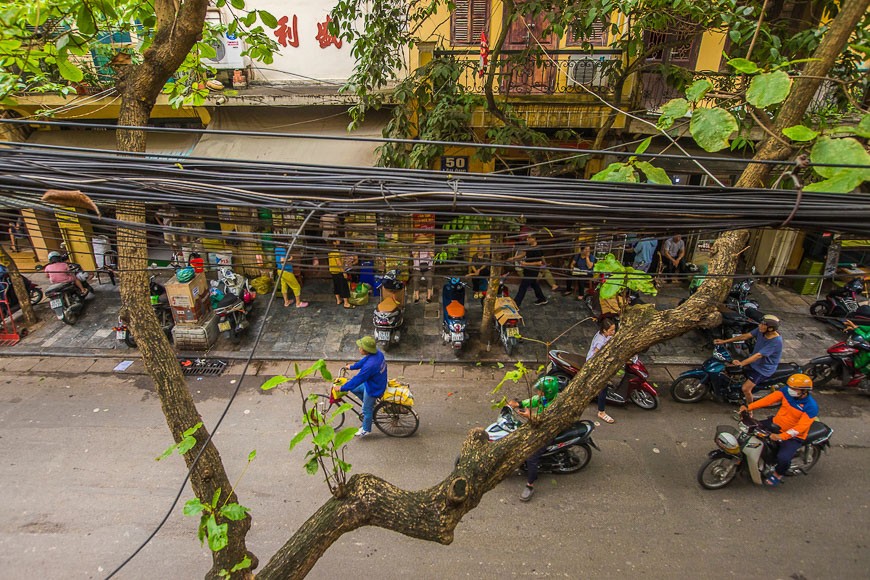 Hanoi Old Quarter street view
Hanoi Old Quarter street view
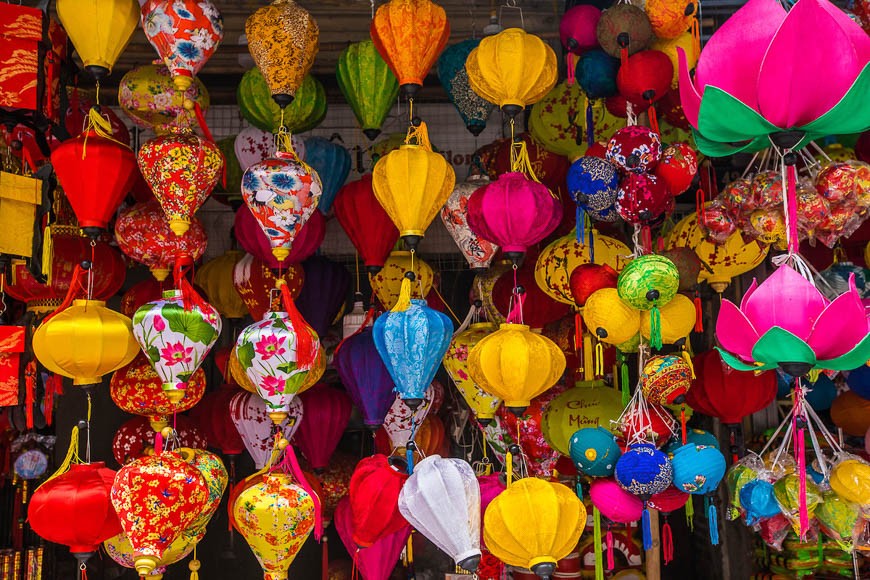 Local craft store Hanoi Old Quarter
Local craft store Hanoi Old Quarter
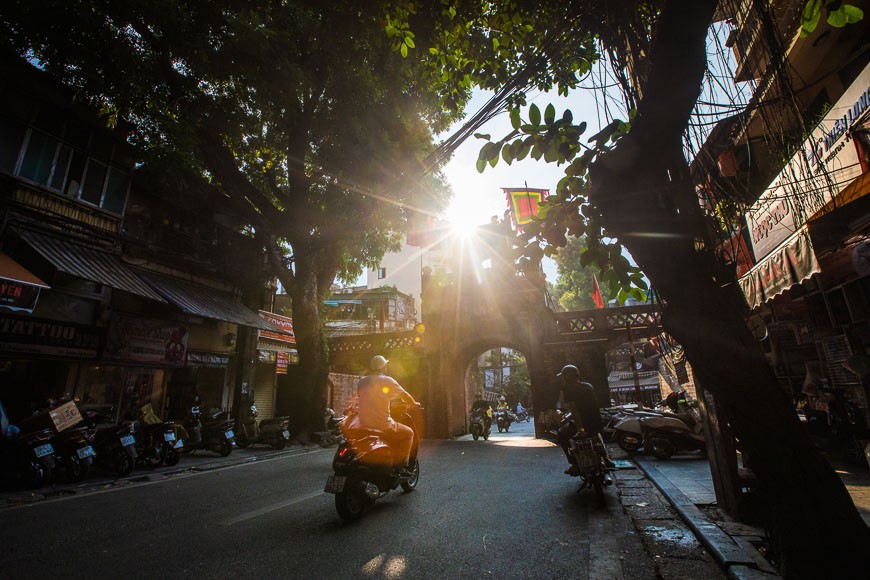 Old Quarter gate O Quan Chuong
Old Quarter gate O Quan Chuong
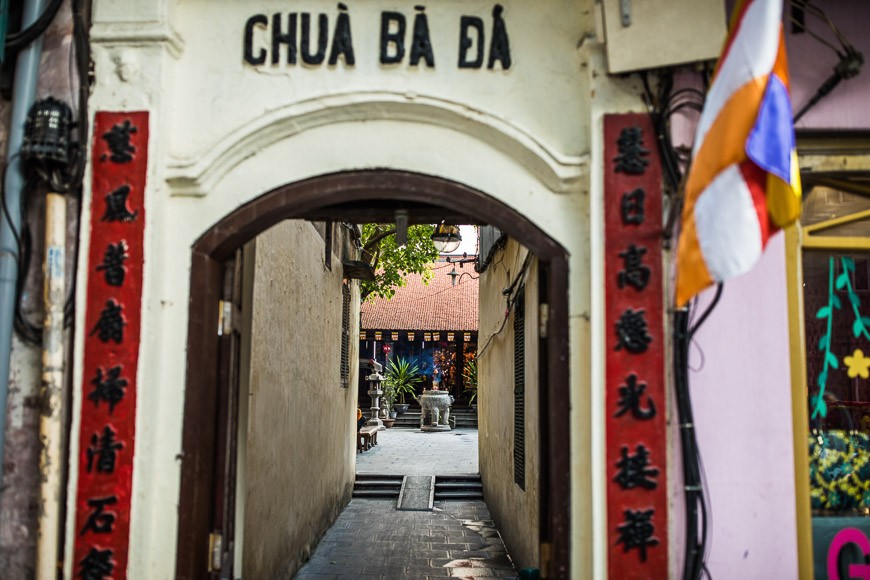 Ba Da Pagoda entrance Hanoi Old Quarter
Ba Da Pagoda entrance Hanoi Old Quarter
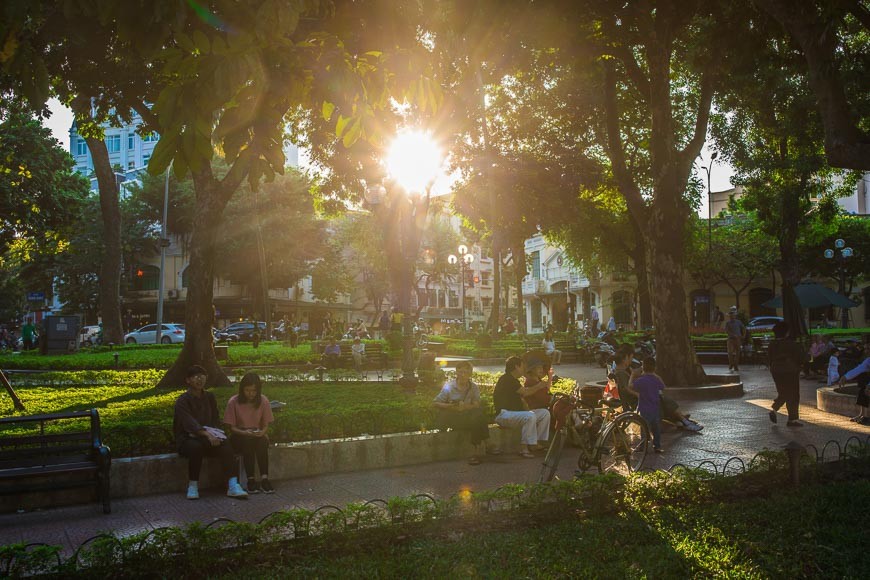 Hoan Kiem Lake view Hanoi Old Quarter
Hoan Kiem Lake view Hanoi Old Quarter
 Turtle Tower scenic view Hanoi Old Quarter
Turtle Tower scenic view Hanoi Old Quarter
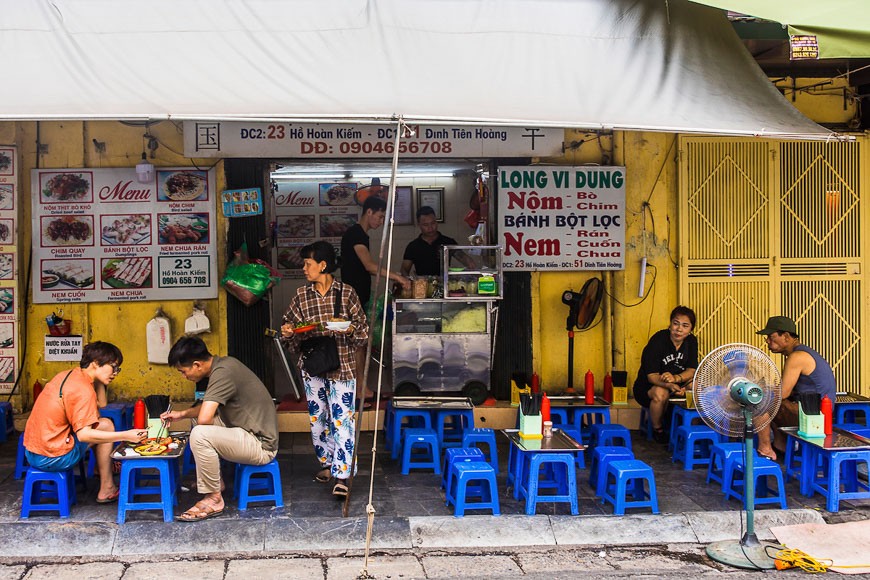 Local street food market Hanoi Old Quarter
Local street food market Hanoi Old Quarter
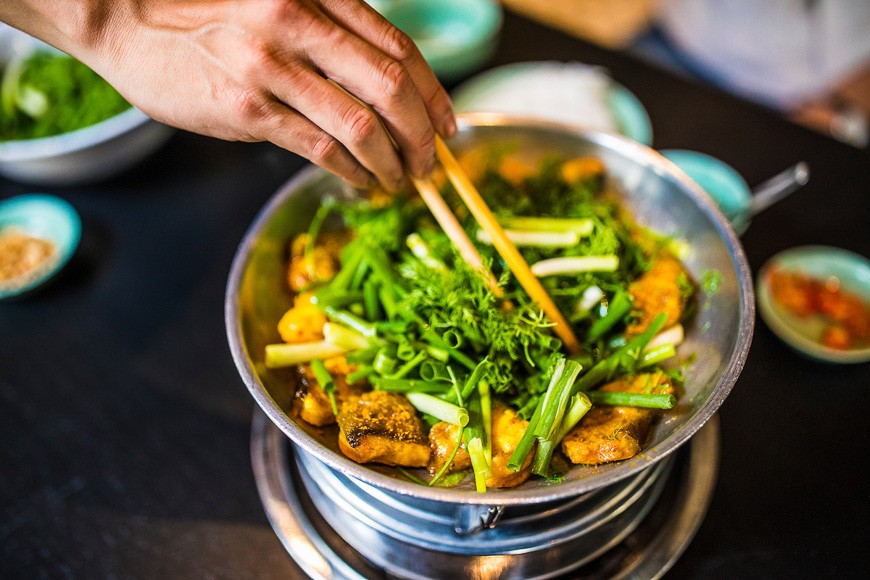 Specialty dish advertisement Hanoi Old Quarter
Specialty dish advertisement Hanoi Old Quarter
 Cool collectables store Hanoi Old Quarter
Cool collectables store Hanoi Old Quarter
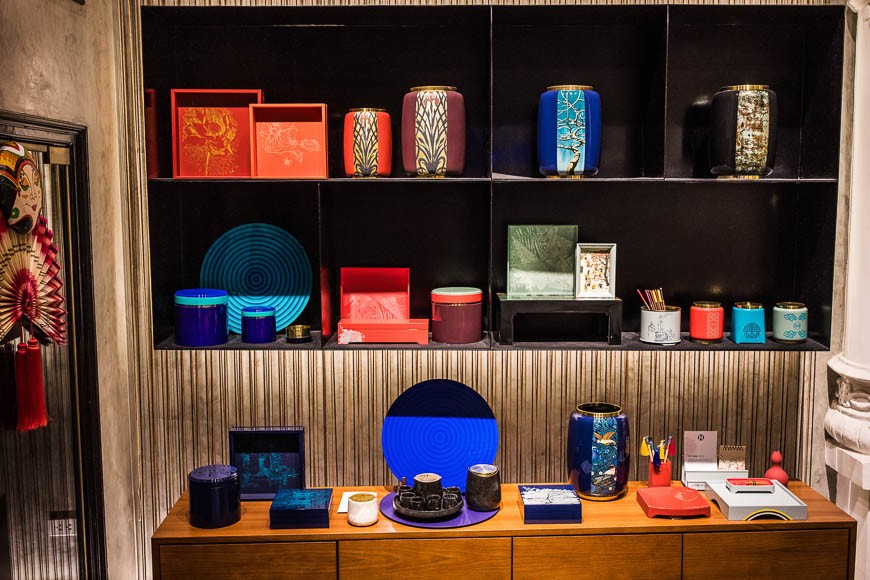 Embroidery and textiles store Hanoi Old Quarter
Embroidery and textiles store Hanoi Old Quarter
 Diamond Sky Bar view Hanoi Old Quarter
Diamond Sky Bar view Hanoi Old Quarter



